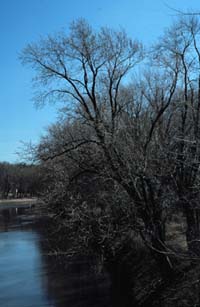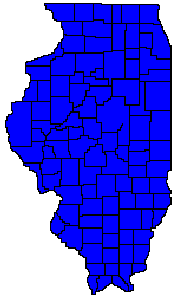 |
| Silver
Maple (Acer saccharinum)
Distribution
Map to Right |

Silver maple, also known as soft maple, is a medium to large tree from 60 to 100 feet tall. The trunk diameter may be as great as 5 feet. The branches rise to form a broadly spreading, rounded crown.
Silver maple is a very common tree in Illinois. It grows in wet soils and moist and rich soils throughout the state. It is also a common tree throughout the eastern deciduous forest.
Interesting
Facts
Silver
maple has sap that is sweet, but not as sugary as sugar maple sap. Its
twigs have an unpleasant odor when broken. The tree is fast growing, but
the branches are very brittle and the root system shallow, making it a
poor choice as an ornamental. It is also susceptible to a number of diseases
and insect damage.
Identifying Features
BarkUses
Silver maple bark is pale gray and smooth when young. As the tree grows older, the bark becomes develops scaly plates, becoming almost shaggy.
Leaves
The leaves are simple and opposite, up to 8 inches long and almost as wide. They have 5 deeply incised palmate lobes and the leaf margins are toothed. Leaves are green and shiny on the surface and pale or silvery green and sometimes sparsely hairy on the underside. The leaves turn yellow to red in the autumn. The twigs are slender, red-brown, and often curve upward.
Flowers
Male and female flowers occur separately either on the same tree or, more commonly, on different trees. Flowers appear in yellowish green clusters in early spring before the leaves begin to unfold.
Fruits
The fruits are "helicopter" fruits. They occur in attached pairs, are up to 3 inches long, and consist of green or yellow wings with large seeds at the base. Fruits appear from April to June.
Silver maple wood is hard, but brittle. It is used for low quality furniture and flooring.